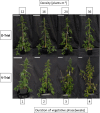The effects of plant density and duration of vegetative growth phase on agronomic traits of medicinal cannabis (Cannabis sativa L.): A regression analysis
- PMID: 39774473
- PMCID: PMC11684660
- DOI: 10.1371/journal.pone.0315951
The effects of plant density and duration of vegetative growth phase on agronomic traits of medicinal cannabis (Cannabis sativa L.): A regression analysis
Abstract
Empirical data on the effect of plant density (PD) and length of the vegetative phase (DVP) on plant growth, yield, and cannabinoid concentration of medicinal cannabis (Cannabis sativa L.) are still scarce, leading to a lack of specific cultivation recommendations. We conducted two greenhouse experiments to investigate the effect of PD in the range of 12-36 plants m-2 (D-trial) and DVP in the range of 1-4 weeks (V-trial) on plant morphology, biomass growth of individual plant organs, and CBD concentration of individual inflorescence fractions. Empirical models for the relationships between the investigated plant traits and PD/DVP were created using linear regression analysis preceded by a lack-of-fit test. An increase in PD led to a linear decrease in inflorescence yield per plant (p = 0.02), whereas a positive linear relationship was found for inflorescence yield (p = 0.0001) and CBD yield (p = 0.0002) per m2. Total area yields in the D-trial ranged from 119 to 247 g m-2 from lowest to highest PD. DVP showed a positive linear relationship with inflorescence yield on an individual plant (p = 0.0001) and area basis (p < 0.0001) along with most other relevant agronomic traits such as CBD production, plant size and lateral shoot length. Total area yields in the V-trial ranged from 295 to 571 g m-2 from lowest to highest DVP. The yield increase could be linked to the increased inflorescence number per plant rather than inflorescence size. In contrast to expectations, neither PD nor DVP had significant effects on the cannabinoid concentration gradient from upper to lower canopy layers. CBD concentrations in inflorescences from lower canopy layers were reduced by 23% in the V-trial and 46% in the D-trial. However, with increasing PD, the proportion of higher-concentrated inflorescence fractions from upper canopy layers increased from 46% to 68%, while an extension of DVP shifted this proportion only marginally from 45% to 50%. In the context of standardized production, we therefore advocate high-density production systems that increase the proportion of desired inflorescence fractions from upper canopy layers.
Copyright: © 2024 Schober et al. This is an open access article distributed under the terms of the Creative Commons Attribution License, which permits unrestricted use, distribution, and reproduction in any medium, provided the original author and source are credited.
Conflict of interest statement
The authors have declared that no competing interests exist.
Figures










References
-
- Flores-Sanchez IJ, Verpoorte R. Secondary metabolism in cannabis. Phytochem Rev. 2008; 7:615–39. doi: 10.1007/s11101-008-9094-4 - DOI
-
- Bolchi C, Pallavicini M, Casagni E, Vieira de Manincor E, Gambaro V, Dei Cas M, et al.. Development and Early Identification of Cannabis Chemotypes during the Plant Growth: Current Analytical and Chemometric Approaches. Anal Sci. 2021; 37:1665–73. Epub 2021/07/23. doi: 10.2116/analsci.21R004 . - DOI - PubMed
MeSH terms
Substances
LinkOut - more resources
Full Text Sources

